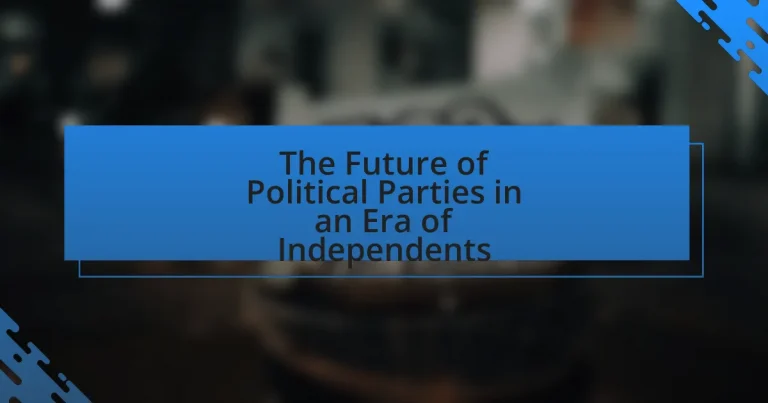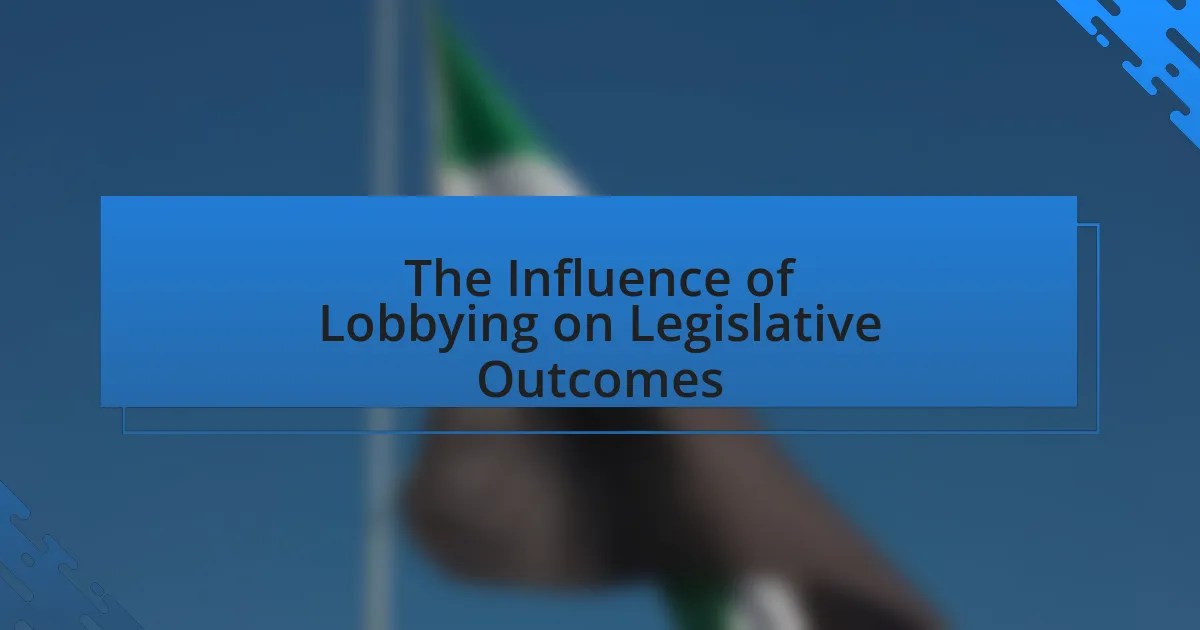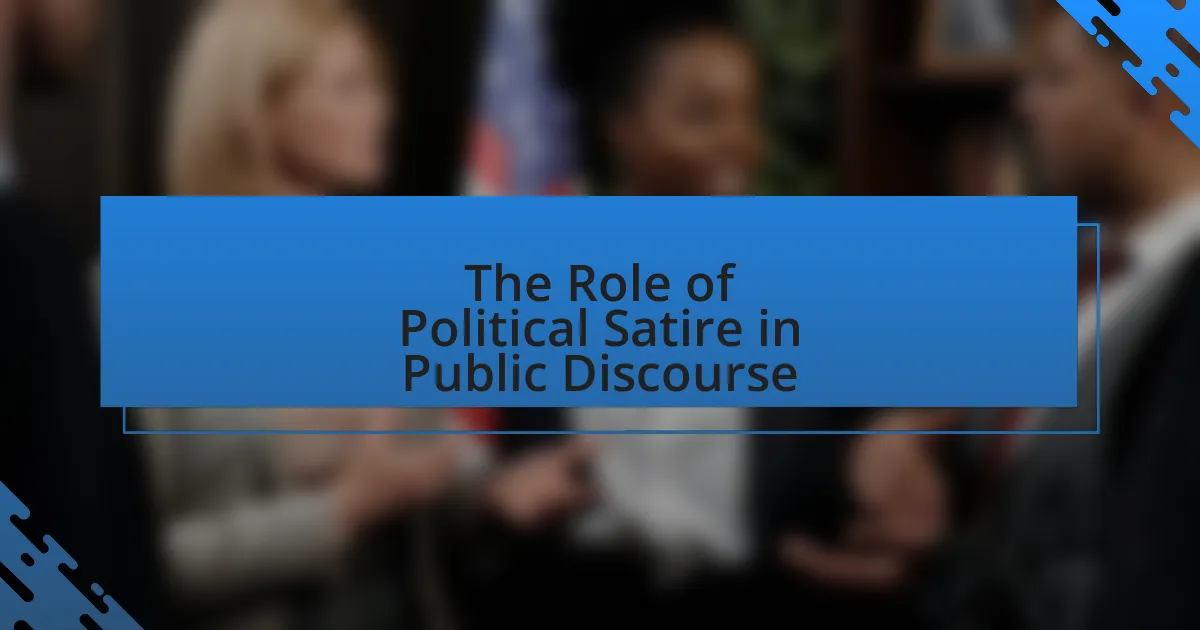The article examines the evolving landscape of political parties in the United States as the number of independent voters continues to rise. With 41% of voters identifying as independents, traditional political parties are compelled to adapt their strategies and platforms to remain relevant. The discussion highlights the characteristics that differentiate political parties from independents, the influence of independents on electoral outcomes, and the challenges parties face in engaging this demographic. Additionally, it explores the implications of forming coalitions with independents and the potential future scenarios for political parties in an increasingly fragmented political environment.
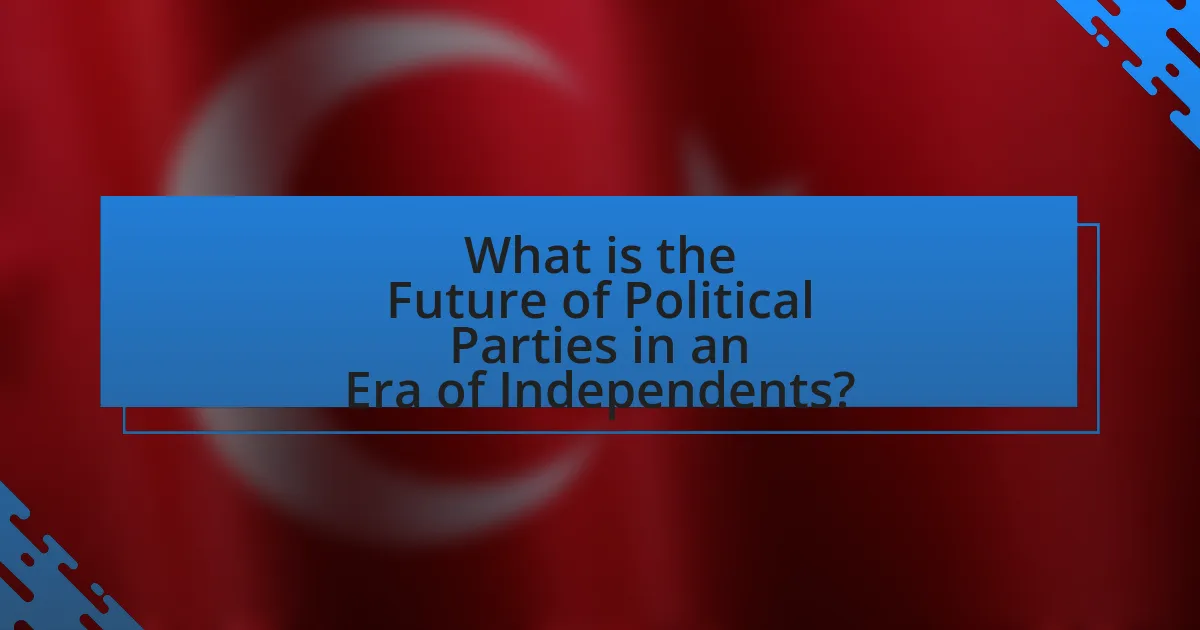
What is the Future of Political Parties in an Era of Independents?
The future of political parties in an era of independents is likely to involve significant adaptation and transformation. As voter trends indicate a growing preference for independent candidates, political parties may need to reassess their platforms and strategies to remain relevant. For instance, a 2020 Gallup poll revealed that 62% of Americans identified as independents or leaned toward independent views, highlighting a shift away from traditional party affiliation. This trend suggests that political parties could increasingly focus on coalition-building and issue-based politics to attract independent voters, potentially leading to a more fragmented political landscape where parties must compete more vigorously for support.
How are political parties currently defined in the context of independents?
Political parties are currently defined as organized groups that seek to gain political power, while independents are individuals who do not align with any specific party. This distinction highlights the growing trend of voters identifying as independents, which has increased significantly in recent years; for instance, a 2020 Gallup poll indicated that 40% of U.S. voters identified as independents, reflecting a shift away from traditional party affiliation. Consequently, political parties are adapting their strategies to engage this demographic, recognizing that independents can significantly influence election outcomes and policy decisions.
What characteristics distinguish traditional political parties from independents?
Traditional political parties are characterized by structured organization, established platforms, and formal membership processes, while independents lack these formal structures and often prioritize individual beliefs over party ideology. Traditional parties typically have a clear hierarchy, defined leadership, and a cohesive set of policies that guide their actions, as seen in major parties like the Democratic and Republican parties in the United States. In contrast, independents operate without a formal affiliation, allowing for greater flexibility in political stance but often resulting in less influence in the electoral process. This distinction is evident in electoral systems where traditional parties dominate ballot access and funding, while independents face challenges in gaining visibility and support.
How do independents influence the political landscape?
Independents influence the political landscape by acting as swing voters and shaping electoral outcomes. Their ability to vote outside traditional party lines allows them to sway elections, particularly in closely contested races. For instance, in the 2020 U.S. presidential election, approximately 35% of voters identified as independents, significantly impacting the results in key battleground states. This demographic often prioritizes issues over party affiliation, compelling major parties to adapt their platforms to attract these voters. Consequently, independents can drive policy discussions and force parties to address a broader range of concerns, ultimately reshaping the political dialogue.
Why is the rise of independents significant for political parties?
The rise of independents is significant for political parties because it indicates a shift in voter preferences away from traditional party affiliations. This trend challenges the established two-party system, as evidenced by the increasing percentage of voters identifying as independents, which reached approximately 40% in recent surveys. Political parties must adapt their strategies to engage this growing demographic, as independents often prioritize issues over party loyalty, influencing election outcomes and policy discussions.
What trends indicate a shift towards independent candidates?
Trends indicating a shift towards independent candidates include increasing voter dissatisfaction with traditional political parties, a rise in the number of voters identifying as independents, and successful independent campaigns in various elections. For instance, a Gallup poll from 2021 showed that 41% of Americans identified as independents, the highest percentage recorded. Additionally, independent candidates have gained traction in key elections, such as the 2018 gubernatorial race in Maine, where an independent candidate won, demonstrating the viability of non-party-affiliated candidates. These factors collectively highlight a growing preference for independent candidates among the electorate.
How do voter preferences reflect the growing support for independents?
Voter preferences indicate a significant shift towards independents, as evidenced by increasing numbers of voters identifying as independents rather than aligning with traditional parties. According to a Gallup poll from 2023, 41% of registered voters identified as independents, marking the highest level in over a decade. This trend reflects a growing discontent with the two-party system, as many voters seek alternatives that better represent their views. Additionally, exit polls from recent elections show that independents often play a decisive role, influencing outcomes in key races, further underscoring their rising importance in the political landscape.
What challenges do political parties face in adapting to this new era?
Political parties face significant challenges in adapting to the new era characterized by a rise in independent voters. One major challenge is the increasing fragmentation of the electorate, as more individuals identify as independents rather than aligning with traditional party affiliations. According to a 2020 Gallup poll, 40% of U.S. voters identified as independents, highlighting the need for parties to appeal to a broader base. Additionally, political parties struggle with the rapid evolution of communication technologies, which have shifted how voters engage with political content and candidates. This shift requires parties to innovate their outreach strategies to remain relevant. Furthermore, the polarization of political discourse complicates coalition-building efforts, as parties must navigate extreme viewpoints within their ranks while trying to attract moderate voters. These factors collectively challenge political parties to rethink their strategies and adapt to a changing political landscape.
How do political parties respond to the increasing popularity of independents?
Political parties respond to the increasing popularity of independents by adjusting their strategies to attract these voters. For instance, parties may adopt more centrist positions or broaden their platforms to encompass a wider range of issues that resonate with independent voters. According to a 2020 Pew Research Center study, nearly 40% of voters identified as independents, prompting parties to focus on outreach efforts and policy proposals that appeal to this demographic. Additionally, political parties often increase their engagement through targeted campaigns and grassroots initiatives to build relationships with independent voters, recognizing their potential influence in elections.
What strategies can political parties employ to remain relevant?
Political parties can remain relevant by adapting their platforms to reflect the evolving values and concerns of the electorate. This includes engaging in grassroots movements, utilizing digital communication strategies, and forming coalitions with independent candidates to broaden their appeal. For instance, a study by the Pew Research Center in 2020 indicated that younger voters prioritize issues like climate change and social justice, prompting parties to incorporate these topics into their agendas to attract this demographic. Additionally, leveraging social media for direct communication allows parties to connect with constituents in real-time, fostering a sense of community and responsiveness.
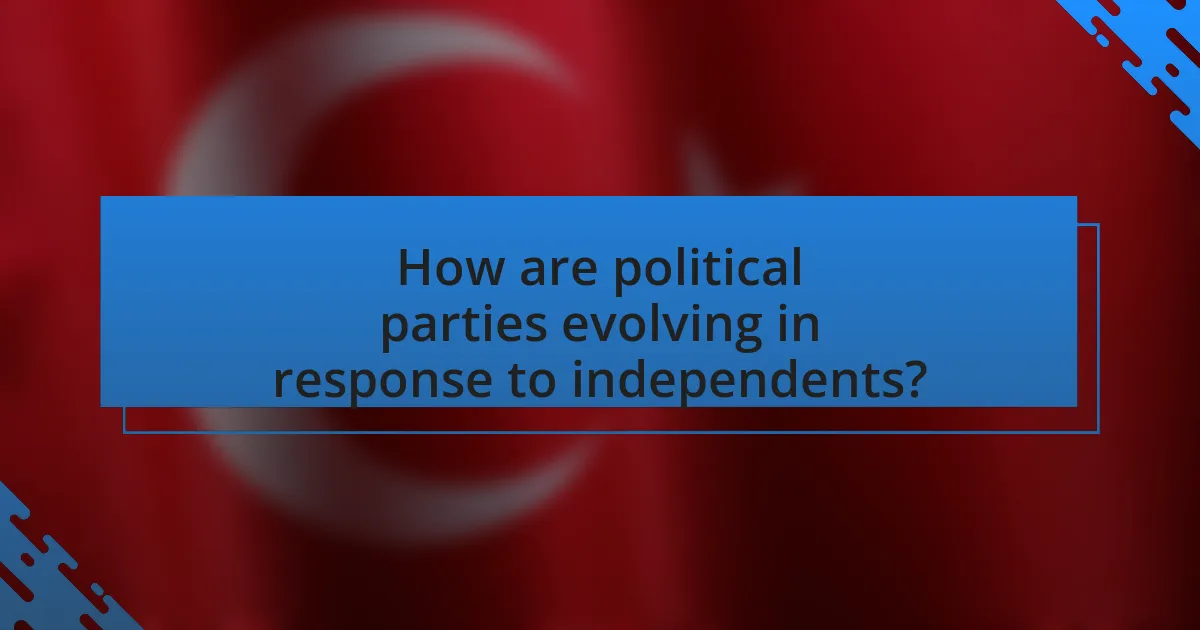
How are political parties evolving in response to independents?
Political parties are evolving by adopting more inclusive platforms and engaging in outreach strategies to attract independent voters. This shift is evident as parties increasingly focus on issues that resonate with independents, such as economic reform and social justice, rather than strictly adhering to traditional party lines. For instance, in the 2020 U.S. elections, both major parties adjusted their messaging to appeal to the growing number of independents, who constituted approximately 40% of the electorate, according to the Pew Research Center. This adaptation reflects a recognition that independents can significantly influence election outcomes, prompting parties to prioritize flexibility and responsiveness in their policies and campaign strategies.
What changes are being implemented by political parties to attract voters?
Political parties are implementing various changes to attract voters, including adopting more progressive platforms, enhancing digital engagement, and focusing on grassroots mobilization. For instance, many parties are shifting their policies to address issues like climate change and social justice, which resonate with younger voters. Additionally, they are leveraging social media and online campaigns to reach a broader audience, as evidenced by the increased use of targeted advertising and virtual town halls during recent elections. This strategic focus on both policy alignment and modern communication methods aims to engage a diverse electorate and counter the rise of independent candidates.
How are political parties modifying their platforms to appeal to independents?
Political parties are modifying their platforms to appeal to independents by adopting more centrist positions and emphasizing issues that resonate with a broader electorate. For instance, many parties are focusing on economic policies that prioritize job creation and healthcare reform, which are key concerns for independent voters. According to a 2022 Pew Research Center study, 60% of independents expressed a desire for political candidates to prioritize bipartisan solutions, indicating that parties are increasingly aligning their platforms with this preference to attract undecided voters. Additionally, parties are incorporating more progressive stances on social issues, such as climate change and racial equality, to engage younger independents who prioritize these topics. This strategic shift reflects an understanding that appealing to independents requires a balance of traditional party values with contemporary issues that matter to a diverse voter base.
What role does technology play in the evolution of political parties?
Technology plays a crucial role in the evolution of political parties by enhancing communication, mobilization, and data analysis capabilities. Political parties utilize social media platforms to engage with voters directly, allowing for real-time feedback and interaction, which has transformed traditional campaigning methods. For instance, the 2008 Obama campaign effectively used social media to mobilize supporters and raise funds, demonstrating how technology can significantly influence electoral outcomes. Additionally, data analytics tools enable parties to target specific demographics with tailored messages, improving voter outreach and engagement. This shift towards technology-driven strategies reflects the changing landscape of political participation, where independent voters increasingly seek direct and personalized communication from parties.
How are coalitions and alliances forming in this new political landscape?
Coalitions and alliances are forming in the new political landscape through strategic partnerships among independent candidates and traditional parties, driven by shared goals and voter demographics. This trend is evident as independents gain traction, prompting established parties to collaborate on key issues like climate change and healthcare to consolidate voter support. For instance, in the 2020 U.S. elections, several independent candidates aligned with major parties to amplify their influence, reflecting a shift towards pragmatic alliances that prioritize electoral success over strict ideological adherence.
What are the implications of forming coalitions with independents?
Forming coalitions with independents can lead to increased electoral success and broader representation. Political parties that align with independents may attract a wider voter base, as independents often appeal to moderate and undecided voters. For instance, in the 2020 U.S. elections, candidates who formed alliances with independent voters saw improved outcomes in competitive districts, demonstrating that such coalitions can enhance legitimacy and voter engagement. Additionally, these coalitions can foster policy innovation, as independents may bring fresh perspectives and priorities that challenge traditional party lines.
How do these alliances affect traditional party dynamics?
Alliances among political groups significantly disrupt traditional party dynamics by fostering collaboration that transcends established party lines. These alliances often lead to the formation of coalitions that can challenge the dominance of major parties, as seen in various electoral contexts where independent candidates or smaller parties unite to increase their electoral viability. For instance, in the 2016 U.S. presidential election, the rise of third-party candidates and independent movements demonstrated how alliances could siphon votes from traditional party candidates, thereby altering the expected outcomes and strategies of major parties. This shift compels traditional parties to adapt their platforms and strategies to remain relevant in an increasingly fragmented political landscape.

What does the future hold for political parties in an era dominated by independents?
Political parties may face significant challenges in an era dominated by independents, as voter preferences shift towards candidates not affiliated with traditional party structures. This trend is evidenced by the increasing number of voters identifying as independents, which reached 41% in the 2020 U.S. presidential election, according to the Pew Research Center. As independents gain influence, political parties may need to adapt their strategies, focusing on broader appeal and addressing issues that resonate with a more diverse electorate. This could lead to a re-evaluation of party platforms and a potential decline in the power of established party hierarchies.
What predictions can be made about the future of political parties?
Political parties are likely to face a decline in traditional membership and influence as more voters identify as independents. This trend is supported by data from the Pew Research Center, which indicates that the percentage of Americans identifying as independents has increased from 30% in 2000 to 44% in 2021. As independents grow in number, political parties may need to adapt their platforms and strategies to appeal to a broader electorate, potentially leading to more centrist policies. Additionally, the rise of digital communication and social media is expected to further fragment political landscapes, allowing for the emergence of new political movements and parties that cater to specific issues rather than traditional party lines.
How might the structure of political parties change in the next decade?
The structure of political parties may evolve significantly in the next decade due to the increasing prominence of independent voters and the rise of digital platforms for political engagement. Political parties are likely to adapt by becoming more decentralized, allowing for greater grassroots involvement and responsiveness to local issues. This shift is evidenced by the growing number of independent candidates successfully running for office, as seen in the 2020 U.S. elections where independent candidates garnered over 20% of the vote in several key races. Additionally, the use of social media and online organizing tools is expected to further democratize party structures, enabling more direct communication between party leaders and constituents.
What potential scenarios could unfold for political parties and independents?
Political parties and independents could face scenarios of increased fragmentation, collaboration, or realignment. Increased fragmentation may occur as voters increasingly identify as independents, leading to a decline in traditional party loyalty, evidenced by a 2020 Gallup poll showing that 40% of Americans identified as independents. Alternatively, collaboration could emerge, where political parties form coalitions with independents to secure legislative majorities, similar to the alliances seen in various state legislatures. Lastly, realignment may happen if major parties adapt their platforms to attract independent voters, as seen in the 1992 U.S. presidential election when Bill Clinton appealed to centrist voters, resulting in a significant shift in party dynamics.
What best practices can political parties adopt to thrive in this environment?
Political parties can thrive in the current environment by embracing inclusivity and adapting to the preferences of independent voters. This involves actively engaging with diverse communities, understanding their needs, and incorporating their feedback into policy development. Research indicates that in the 2020 U.S. elections, independent voters comprised 35% of the electorate, highlighting their significant influence. By prioritizing transparency and fostering open communication, political parties can build trust and loyalty among constituents. Additionally, leveraging digital platforms for outreach and mobilization can enhance engagement, as studies show that online campaigns can effectively reach younger, independent voters.
How can political parties engage with independent voters effectively?
Political parties can engage with independent voters effectively by prioritizing issue-based campaigning that resonates with their values and concerns. Research indicates that independent voters often prioritize specific issues over party affiliation, with a 2020 Pew Research Center study showing that 60% of independents prefer candidates who focus on issues rather than party loyalty. By addressing topics such as healthcare, education, and economic opportunity, political parties can attract independent voters who seek practical solutions rather than partisan rhetoric. Additionally, utilizing digital platforms for outreach and fostering community engagement through town halls can enhance connection and trust with this demographic, as independent voters value transparency and accessibility in political discourse.
What lessons can be learned from successful independent campaigns?
Successful independent campaigns demonstrate the importance of grassroots mobilization and authentic messaging. These campaigns often rely on building strong community connections and engaging directly with voters, which fosters trust and loyalty. For instance, the 2018 gubernatorial campaign of Andrew Yang in New York highlighted the effectiveness of utilizing social media platforms to reach younger demographics, resulting in a significant increase in voter engagement. Additionally, successful independent campaigns often prioritize transparency and accountability, which resonate with constituents seeking alternatives to traditional party politics. This approach can lead to increased voter turnout, as seen in the 2020 election cycle where independent candidates garnered unprecedented support, indicating a shift in voter preferences towards candidates who prioritize issues over party affiliation.
